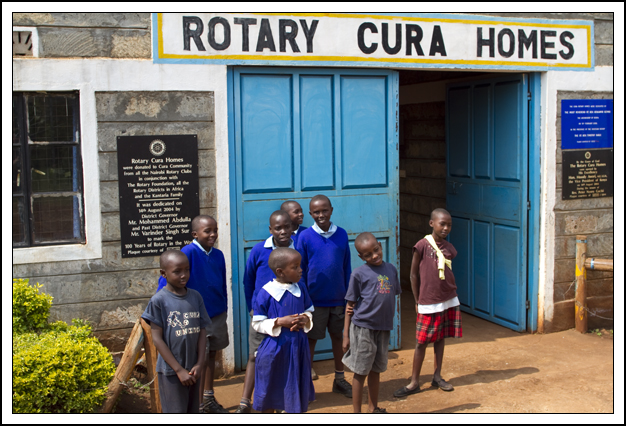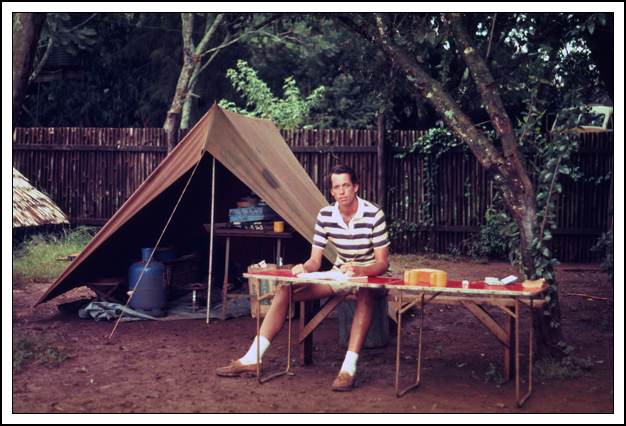Pete McBride, the photographer from National Geographic Traveler, and I arrived at Tribe, our hotel in Nairobi, around noon yesterday. We had just enough time to throw our bags in our rooms and grab a sandwich before meeting the driver who was taking us to the orphanage. This was something Sarah Robarts, who does pr for Tribe, had set up. Sarah, who is originally from Kenya, ran in the Safaricom marathon at Lewa on Saturday (there’s a whole story about running 26 miles in a wildlife conservancy with rhinos and lions and elephants all around but I think that will have to wait for another day) and originally was going to take us out to this Kikuyu orphanage, which is the charity she runs for, but she didn’t get back to Nairobi until yesterday evening, so Pete and I were on our own.
You’d think it would be easy to find an orphanage in Nairobi but this place was out in the country somewhere and our driver got lost a number of times. He’d stop at a fork in the rutted dirt road and look to the left, look to the right, make his decision and we’d travel for maybe a mile or so before he would convince himself he’d gone the wrong way and turn around. This happened three or four times before he finally got around to asking a local or two how to find the orphanage.
Eventually we found it. I don’t know what I was expecting. I mean, if someone told you that you were going to visit an orphanage in Kenya, what would you imagine it would look like? As it turns out, it was a simple rectangular stone structure, built around a courtyard, with two wide blue doors and a sign over them saying ROTARY CURA HOMES. I guess the most interesting thing about it was that there were no children here. At least not when we got there.
Three women, hunched over stools, were sitting around a couple of plastic buckets picking out stones from a basket of red beans. One of the women got up and went to look for the manager of the orphanage, Moses Machara Kamau. Could there be a better name for someone running an orphanage than Moses?
Moses asked one of the ladies to make us some tea and then showed us to his office, a very narrow room with a small desk, an ancient sagging couch, and a small table. As Moses poured us Kenya tea, which is more like chai, I asked him where the kids were. Still in class, next door, he said. They would be back for their afternoon meal in fifteen or twenty minutes, which would allow us time to have our tea and chat a bit first.
Moses Machara Kamau is 54 years old. He has a receding hairline, a suggestion of a moustache, and a gap in his lower front teeth, which is pretty typical for many Kenyans who come from small villages where the lower incisors are removed when they are children so that they can be fed through a straw if they get lockjaw. Since so many children here walk around barefoot, particularly in the outlying villages, tetanus (lockjaw) is a real threat.
Moses told us that he has 50 children at the home—24 boys and 26 girls—all between the ages of 4 and 12. Almost all of the children are there because one or both of their parents have died of HIV-Aids.
The home was built in 2004 with funds from all the Nairobi Rotary Clubs and donated to the Cura community. But they weren’t really able to do anything with it until two years later when they got a grant to hire a manager to run the home. This turned out to be Moses who, at the time, was an elder in the church next door and had a career in the civil service. Moses took some classes to learn about running an orphanage and handling 50 kids (he’s married and has six of his own) and took over four years ago.
I asked him if he liked his job.
He smiled, sipped his tea, and said. “Yes, I enjoy the work. It is difficult but it is important and I like the children very much.” After a pause he added, “And, I think, the children like me.”
And just as he said that, the first rush of children, the boys dressed in blue sweaters and gray or blue shorts, the girls in simple blue dresses, flew into the courtyard like swallows.
“Well,” said Moses, standing up. “I think we must go now and feed my little birds.”




Recent Comments